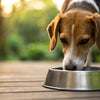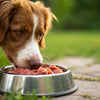How Do I Feed My Dog Raw Food? The Ultimate Guide to a Raw Diet for Dogs
- Houndsy
Table of Contents
- Introduction
- What is a Raw Food Diet for Dogs?
- The Benefits of Feeding Raw Food
- The Risks of Feeding Raw Food
- Making a Raw Food Diet for Your Dog
- Transitioning Your Dog to a Raw Food Diet
- Is a Raw Diet Right for Your Dog?
- Conclusion
Introduction
Did you know that approximately 15% to 25% of dog owners have opted for raw food diets for their pets? As we seek to provide our beloved companions with the best nutrition possible, many of us find ourselves grappling with the question: how do I feed my dog raw food? The raw food movement has gained significant traction recently, drawing attention from both pet owners and veterinary professionals alike. Some swear by the benefits of such diets—ranging from shinier coats to improved digestion—while others express concern about potential risks associated with raw feeding.
In this blog post, we aim to demystify the concept of feeding raw food to dogs. We will cover everything from the building blocks of a raw diet, the benefits and drawbacks, safe handling practices, and guidance on the transition process. By the end, you'll have a comprehensive understanding of how to safely and effectively implement a raw food regimen for your dog, should you choose to do so.
As we explore this topic, we invite you to reflect on your own dog’s nutritional needs and whether a raw diet might be a suitable option. With our information-rich journey, you'll be equipped to make informed decisions that foster your dog's health and well-being.
What is a Raw Food Diet for Dogs?
A raw food diet includes uncooked ingredients, typically focused on high-quality proteins, bone, organs, and occasionally fruits and vegetables. Popularized by the Biologically Appropriate Raw Food (BARF) diet by Dr. Ian Billinghurst in the 1980s, the raw feeding approach mimics what dogs’ ancestors might have eaten in the wild. This has led many pet owners to believe that raw food diets may bring various health benefits to their pets.
Components of a Raw Food Diet
To set the foundation for a balanced raw diet, we can break it down into essential components:
-
Muscle Meat: This should be the primary ingredient, offering high-quality protein necessary for energy and overall health.
-
Organs: These include nutrient-rich options like liver, heart, and kidney, which provide essential vitamins and minerals.
-
Raw Edible Bones: Offering calcium and promoting dental health, these should always be raw and never cooked.
-
Vegetables and Fruits: While optional, they can add antioxidants, fiber, and vitamins beneficial for digestion.
-
Supplements: Depending on the specific dietary needs of your dog, adding items like fish oil or kelp can help create a well-balanced diet.
By incorporating these components thoughtfully, you ensure your dog receives not only the energy they need but also a variety of nutrients that contribute to their overall health.
The Benefits of Feeding Raw Food
Embracing a raw food diet for our dogs is often driven by the perceived benefits. Let's delve into some of the notable advantages:
Enhanced Coat Health
One of the most frequently mentioned benefits of a raw diet is the potential for a shinier coat. Raw food is rich in Omega-3 fatty acids, commonly found in fish and flaxseed, which can help promote healthy skin and a glossy coat.
Improved Digestion
Many dog owners report that their pets experience better digestion on a raw food diet. Raw food typically contains less filler compared to commercial kibble, leading to more efficient digestion and nutrient absorption. You may also notice smaller and firmer stools!
Better Breath and Dental Health
Feeding raw meaty bones provides a natural way for dogs to clean their teeth as they chew, helping to reduce plaque and tartar buildup. This can lead to fresher breath and improved overall dental health.
Increased Energy Levels
A high-quality, protein-rich diet may result in dogs that are more active and energetic. Owners have observed that dogs transitioning to raw diets often display higher stamina and enthusiasm for play.
Weight Management
Dogs fed a raw diet typically consume fewer empty calories, which facilitates better weight management. The need for minimal supplementation with treats also makes it easier to maintain a healthy weight.
The Risks of Feeding Raw Food
While the benefits can be compelling, it is crucial to weigh the potential risks of raw feeding as well:
Bacterial Contamination
Raw meat can harbor harmful bacteria like Salmonella or E. coli. Proper food handling and hygiene practices are vital to minimize contamination risks for both your dog and your household.
Nutritional Imbalance
Creating a truly balanced raw diet can be complex. Ensuring that your dog receives a complete array of nutrients requires careful planning, and deficiencies can arise if the diet lacks variety or balance.
Bone Hazards
Raw bones can be beneficial; however, they also pose risks. Big bones can splinter and create blockages or injuries in the digestive tract. Additionally, very hard bones can fracture your dog’s teeth. Always supervise your dog during feeding and consult a veterinarian or canine nutritionist regarding appropriate bone sizes.
Parasites
Improperly sourced raw meat can contain parasites. Always buy from reputable suppliers, and freeze meat before feeding to reduce the likelihood of parasitic infections.
Making a Raw Food Diet for Your Dog
If you decide to prepare raw food for your dog, it’s important to ensure that the diet is both safe and balanced. Below, we outline some practical steps for preparing raw food at home:
1. Ingredients Selection
Choose high-quality proteins that your dog enjoys. Poultry, beef, lamb, and fish can all be suitable options. Make sure to source meats that are suitable for pets, and avoid from conventional grocery store meats that might not meet the safety standards for raw feeding.
2. Ratios and Composition
Adopt the BARF model to proportion your dog’s diet effectively:
- 70% Muscle Meat
- 10% Raw Meaty Bones
- 10% Organs (with at least 5% liver)
- 10% Fruits and Vegetables
3. Supplements
Consider adding supplements as needed, such as fish oil for Omega-3 or an appropriate vitamin/mineral blend, to ensure dietary balance.
4. Monitor and Adjust
Keeping a close watch on your dog’s health and behavior will help you spot any dietary reactions. Adjust the proportions and varieties of food based on your dog’s specific needs, age, size, and activity level.
5. Safety Practices
Implement rigorous hygiene practices:
- Clean and sanitize all cookware and surfaces after preparation.
- Store raw ingredients separately from human food.
- Wash hands thoroughly before and after handling raw food.
Transitioning Your Dog to a Raw Food Diet
Transitioning to a raw food diet should be approached gradually. Here’s how to do it effectively:
Start Slow
Begin by blending a small amount of raw food with your dog’s existing kibble or cooked diet. Gradually increase the raw portion over a week or two while decreasing the old food.
Monitor Changes
Pay attention to your dog’s reaction throughout the transition. Some may experience soft stools or mild digestive upset initially, which can usually resolve as their digestive system adapts.
Introduce Variety
Once your dog is fully transitioned to raw, aim to incorporate various proteins over time (e.g., chicken, turkey, beef, and fish) to provide balanced nutrition.
Is a Raw Diet Right for Your Dog?
A raw diet can be rewarding for numerous dogs, but it's not universally suitable. Here’s what to keep in mind:
Best Suited For
- Healthy, active dogs with robust digestive systems.
- Dogs with allergies to common fillers in commercial diets.
- Canines in need of weight management.
When to Be Cautious
- Puppies and seniors who have specific dietary requirements.
- Dogs with health issues, such as pancreatitis or weakened immune systems.
- Households with vulnerable individuals (e.g., pregnant women, young children, and the elderly) who may be at higher risk for infection from bacteria or pathogens.
Mixing Kibble and Raw
For those hesitant to fully commit to a raw diet, mixing high-quality kibble with raw food can be a balanced solution. This hybrid approach allows you to enjoy the benefits of both while providing your dog with a diverse diet. Ensure that you choose reputable brands for both types of food to maintain nutritional integrity.
Conclusion
Feeding your dog a raw food diet is a significant choice that requires careful thought and planning. We've explored the components of a raw diet, the accompanying benefits and risks, and offered practical tips for safely preparing and transitioning your dog's meals. With the right approach, a raw diet can potentially enhance your dog's health and vitality, aligning with our mission at Houndsy to improve daily pet care experiences.
As you reflect on your dog's nutritional needs and feeding habits, consider how our Houndsy Kibble Dispenser could complement your pet care routine. It simplifies portion control and ensures my dog's meals remain consistent, no matter which feeding approach you choose. Discover more about the Houndsy Kibble Dispenser here.
FAQ
1. What should I include in my dog's raw food diet?
Your manual should be composed of muscle meat, organs, raw bones, and optional fruits and vegetables while ensuring that the ratio aligns with recommended guidelines.
2. How can I safely handle raw food for my dog?
To minimize risks, keep raw food separate from other foods, wash your hands thoroughly, and disinfect surfaces after handling raw ingredients. Always buy from reputable suppliers.
3. Can I feed my dog both kibble and raw food?
Yes, mixing both is a great way to offer nutritional diversity while taking advantage of the benefits associated with each type.
4. What are the signs that a raw diet is not suitable for my dog?
Watch for gastrointestinal upset, sudden changes in weight, or any allergic reactions. Always consult with your veterinarian for personalized advice.
5. Is raw feeding too expensive compared to kibble?
While this can vary based on your choice of ingredients, high-quality raw food can be cost-effective in the long run. Cheaper options should be avoided, as the potential for compromised quality rises.
Transitioning to a raw diet is a rewarding journey when done with care and consideration. Happy feeding!












